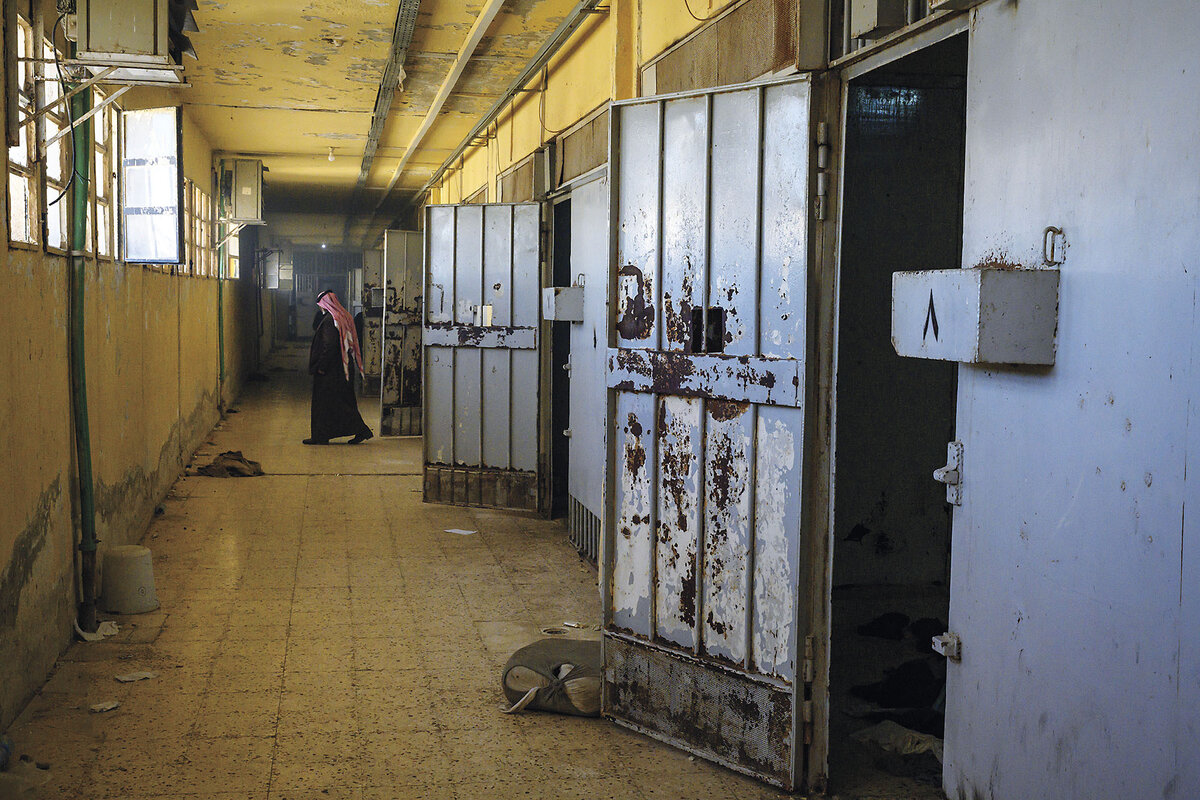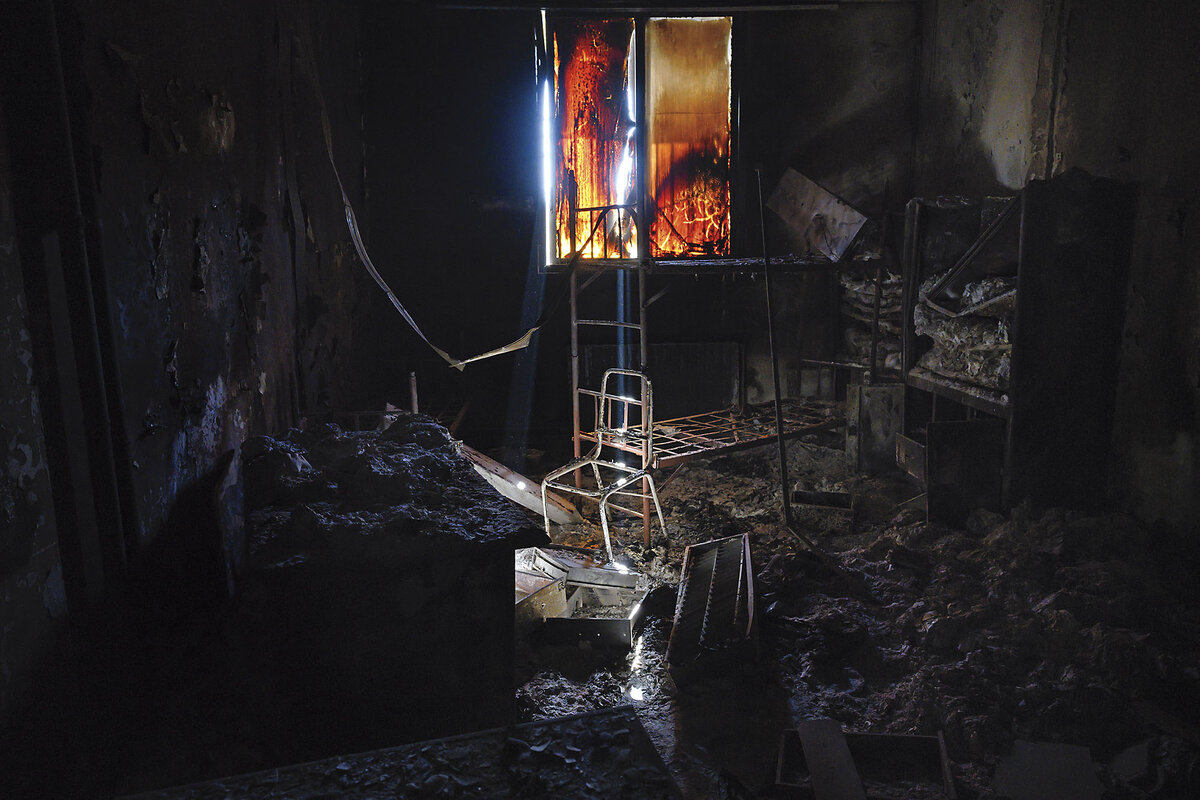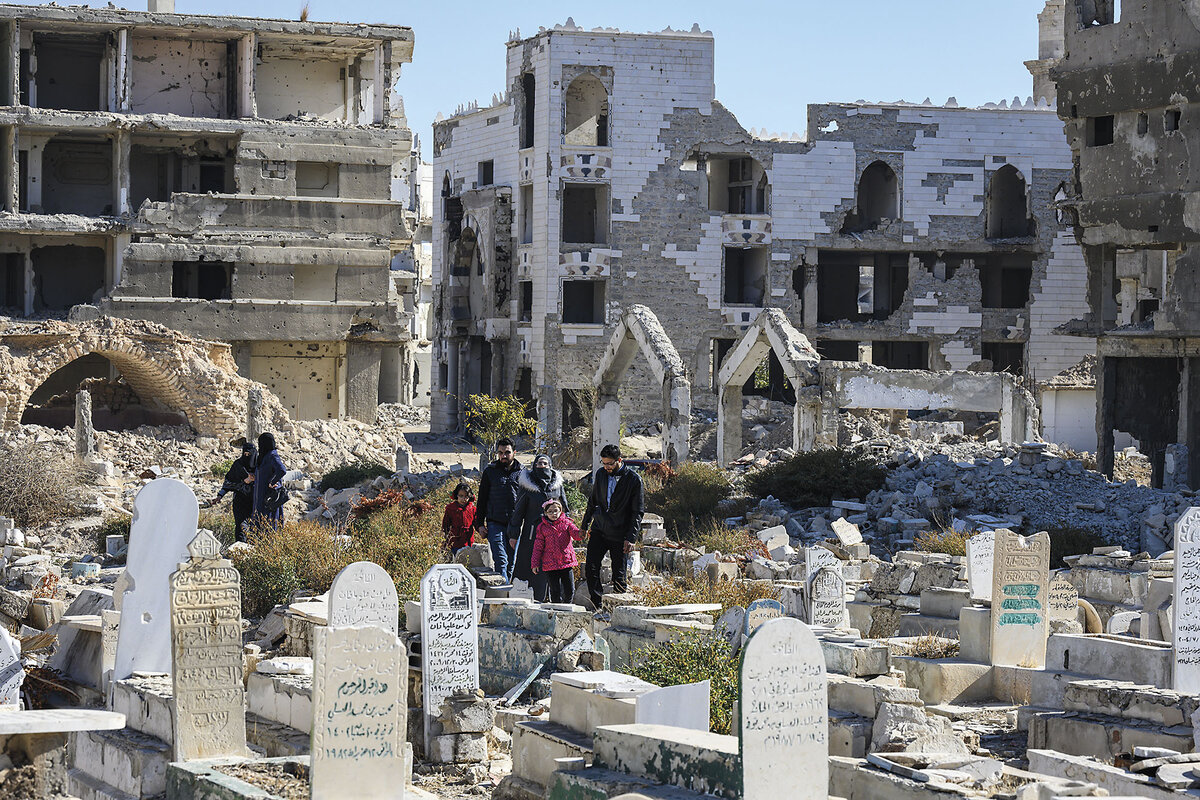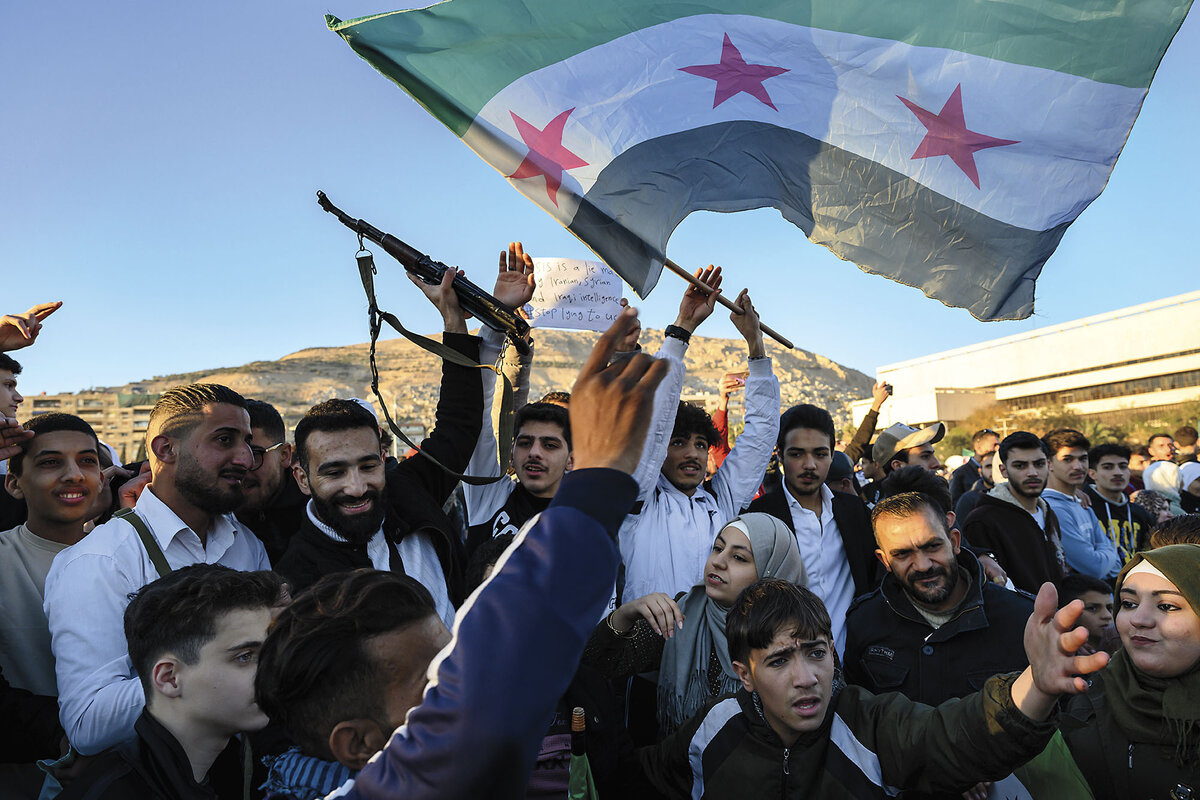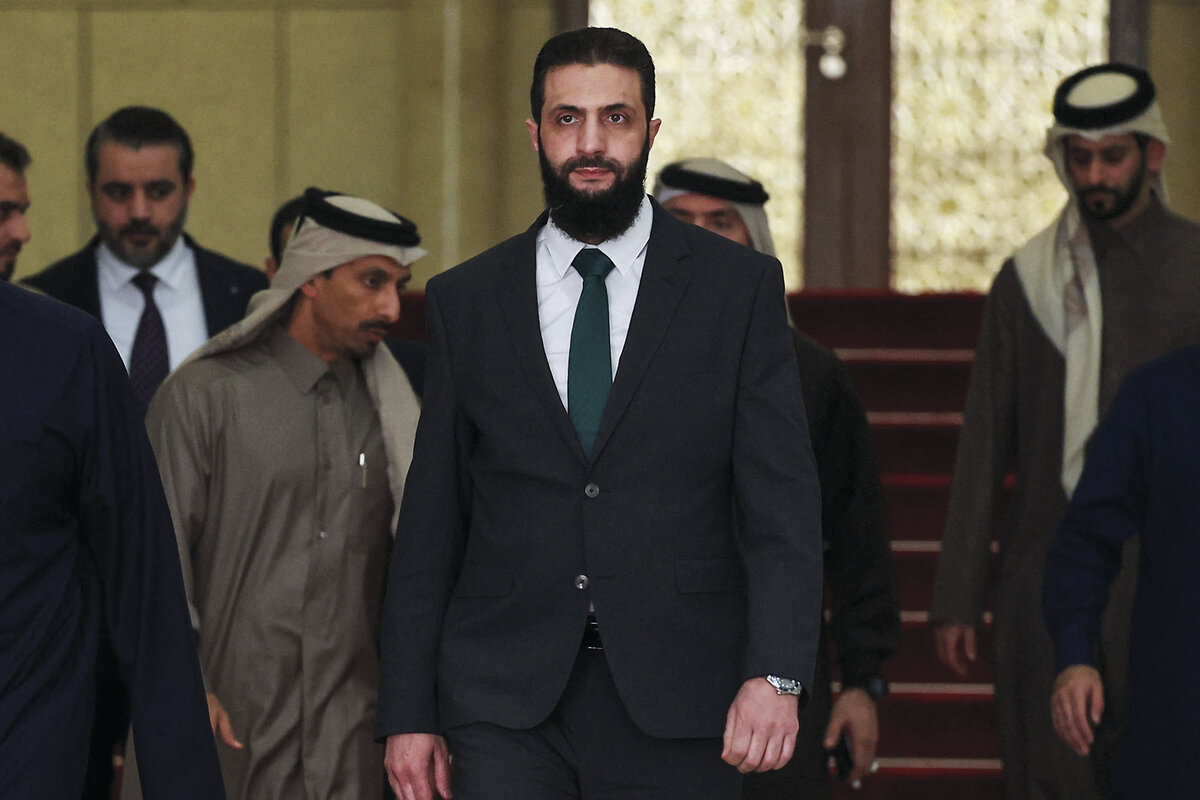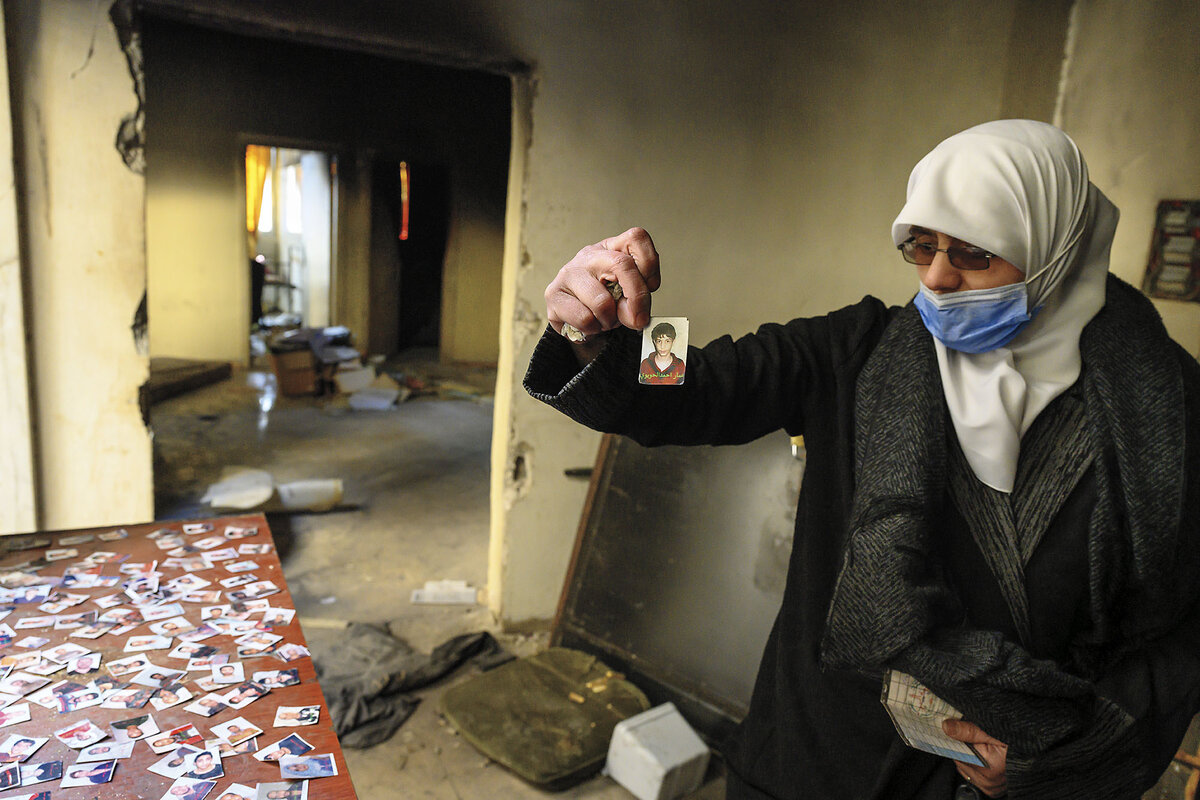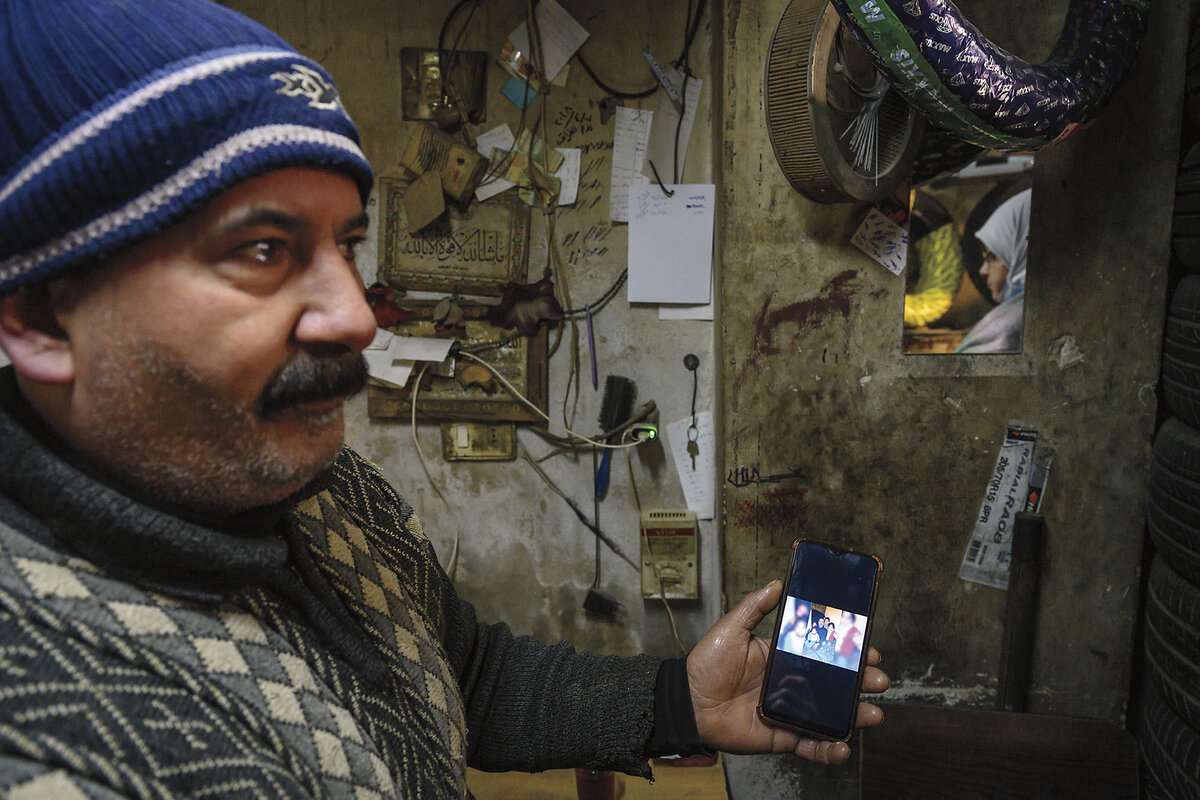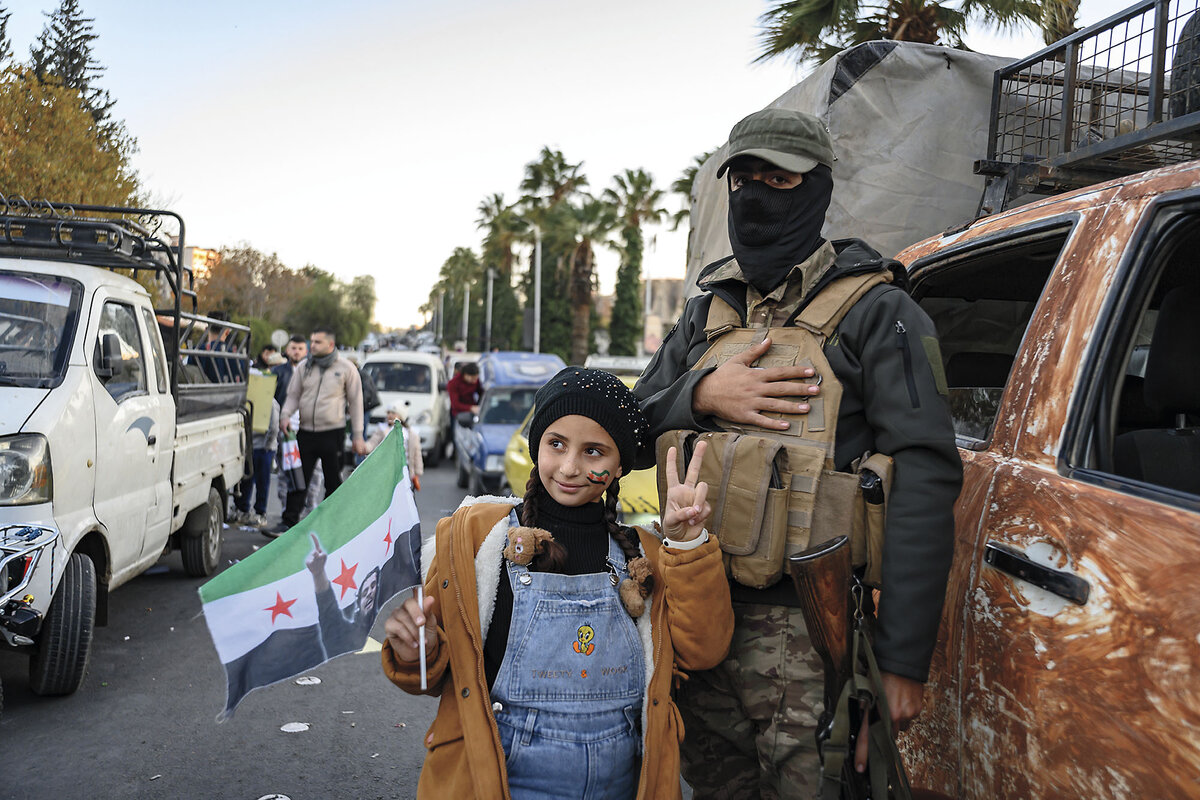After Assad’s fall, Syrians search for lost loved ones – and a path forward
Loading...
| Damascus and Homs, Syria
Hamed is driving away from the gates of Syria’s infamous Sednaya Military Prison with a steady grip on the wheel. The sun is shining outside, but the darkness of the multistory complex – a network of torture chambers and cold cells cut off from the outside world by concrete walls and a latticework of braided barbed wire – is overwhelming.
“I, too, was held in Sednaya,” the Syrian taxi driver suddenly blurts. He had been incarcerated there for seven years.
“Thank God you are here,” replies Walaa, a schoolteacher and the Monitor’s translator. The exceptionally high death rate among inmates at Syria’s archipelago of prisons and detention centers is well known.
Why We Wrote This
For over 50 years, the Assad regime had a brutal network of prisons. Now that it has fallen, Syrians search for missing loved ones, seeking justice as they rebuild their society.
Hamed pauses and then takes a sharp breath. “Thank God I am here,” he agrees, his voice suddenly wavering from the effort to keep composed. “But I am sad for all those who are gone. All those people. What did they do? What fault do they have? I cry remembering.”
His pain pours out, like a long cry from Syria’s dungeons, a cry that was silenced during more than half a century of rule by brutal despots, Bashar al-Assad, and his father, Hafez, before him.
The former Sednaya inmate describes how his family paid exorbitant sums for “gentle” treatment in a place of torture and death. In reality, that payoff put him in the kitchen and gave him other duties – such as carrying the bodies of dead inmates into a room where they were sprayed with dissolving chemicals.
After stunned silence, Walaa ventures a follow-up question. ‚ÄúDo you remember names and faces? Was there anyone from Douma in your cell?‚Äù she asks, referring to a town near Damascus that was held by rebels from 2012 until 2018. (To protect Walaa, Hamed, and some others in this story, their surnames have been withheld.)¬Ý
Walaa is still reeling from our visit to Sednaya, where Syrians frantically picked through documents strewn about the floors. They were searching for information about missing loved ones. Others were digging a multitude of holes, clawing for hidden underground cells.
She had seen a large mechanical device with two flat sides and a pressure gauge, which former inmates said was used to crush people. She also saw two blue-painted vats of acid. Add to that a gruesome basement room overflowing with stinking sewage. There were bone cutters there.¬Ý
Yes, Hamed remembers a man from Douma. He was tall, a broad-brush painter. The man had two children and a third on the way. Walaa pales. The description matches her cousin Mohamed, who fought the regime. He was captured on the front line in 2015, and was rumored to have ended up in Sednaya.
She shows Hamed a digital photo of her cousin on her phone.¬Ý
He confirms: Mohamed is dead.
The past screams out for justice
That brief, random exchange between two Syrians – strangers to each other, but fellow victims of the most chronically repressive regime in the Middle East – illustrates the widespread scale of suffering that shredded the fabric of Syrian society for decades, touching every household.
Then the regime was overthrown in a lightning offensive by an Islamist-led patchwork of rebels on Dec. 8.
The Assad dynasty ruled Syria with an iron fist, using a personality cult and an indefatigable security apparatus ‚Äì aspects of daily life for a half century that will require years to overcome and to heal.¬Ý
Syrians now emerging to breathe free air for the first time are only beginning to expose those mechanisms of regime control ‚Äì which expanded exponentially after a 2011 Arab Spring uprising against Assad rule.¬Ý
In 2021, the Office of the United Nations High Commissioner for Human Rights reported that 580,000 Syrians killed in the previous decade was a “minimum verifiable number.” The Syrian Network for Human Rights has counted more than 100,000 additional Syrian men, women, and children who were “forcibly disappeared” since 2011. It reported that more than 15,000 had died under torture.
After rebels with jihadist roots forced Mr. Assad to flee to Moscow in December, Syrians have joyfully celebrated their release from these state-sanctioned horrors. On their side is the fact that the regime crumbled so quickly.
Despite years of lifesaving support during the civil war from Russia, Iran, and Lebanese Hezbollah, Syria’s corrupt armed forces turned brittle. As a result, Damascus and other key cities did not endure another wave of destruction.
Yet as different factions begin to shape the country‚Äôs post-Assad future, the past screams out for justice.¬Ý
Most of the regime’s legion of torturers, internal spies, and enablers remains in the country. Ordinary Syrians like Hamed and Walaa are aghast as the scale of their criminal cruelty continues to be revealed.
Even by the standards of the most brutal tyrannies in the Middle East, Syria is in a special league. When American forces invaded Iraq and overthrew Saddam Hussein in 2003, for example, they expected to find warehouses full of videotapes of torture sessions, and manifest evidence of crimes against humanity.
There certainly were large burial grounds outside Iraq’s notorious Abu Ghraib prison, with each grave identified only by a stone painted with a number. There was plenty of testimony of past episodes of widespread regime brutality, such as the crushing of a Shiite uprising in 1991. But there was less evidence of systematic, ceaseless brutalization of the state against its people.
“These [Syrian] guys make Saddam look like a kitten,” says Iraqi journalist and author Ghaith Abdul-Ahad, shaking his head in a room in Sednaya prison.
Syrians are still discovering burial sites in the capital and across the country – mass graves they believe to contain tens of thousands of victims. Coping with the aftermath of such societal trauma will be a critical challenge for Syria’s new rulers. How can they, as well as Syrian citizens, build a different future while demanding accountability?
As new president Ahmed al-Sharaa takes power, past traumas endure
The pain of Sednaya is kitchen talk in this nondescript second-story apartment in Homs, a city in central Syria.
A group of women is talking about how the men of the family came home from prison traumatized and broken. The city was one of the epicenters of Syrian protests in 2011, protests that began peacefully but gave way to armed resistance after the government unleashed massive, lethal force on protest hubs across the country.
“My big brother Barakat was detained for five years in Sednaya,” says Zikra al-Saleh, a young mother with almond eyes and unruly brown hair. “He came out like a completely crazy person. So thin.”
It took three months of treatment in an intensive care unit, followed by years of loving family support, to nurse him back to a semblance of normality. Years later, however, he still wakes up at night screaming, “Don’t hit me!” The bruises of beatings still show on the soles of his feet and back.
Four of her brothers, says Ms. al-Saleh, spent years as rebel fighters in the Old City of Homs. Under siege, they endured such hunger that they ate tree leaves. The youngest, Hussam, spent two years in various detention centers before finally ending up in Palmyra prison.
“He was tortured so much,” Ms. al-Saleh says. “All that because we asked for freedom.”
The list of grievances appears endless against Syria‚Äôs Alawite community, a minority sect of roughly 13% of the population, and to which Mr. Assad and many high-ranking former regime figures belong.¬Ý
The city of Homs itself is a microcosm of Syria, where Sunni Muslims are the majority, but also where religious and ethnic diversity has long been a point of cultural and national pride.¬Ý
But as family trauma in Syria is expressed in long lists of names and multiple dimensions of torture and suffering, without justice, such diversity could be a ticking time bomb in a society fractured along many lines.¬Ý
From the outset, Mr. Assad cast himself as a secularist preserving the nation from foreign conspiracies and jihadist forces. Now rebels with Al Qaeda roots but who have for years demonstrated more moderate behavior are at the helm of the nation. They have called for national unity and tried to keep acts of revenge in check.
After more than 50 years of torture, killings, and civil war in Syria, the new de facto leader, Ahmed al-Sharaa, might appear an unlikely candidate to begin building an enlightened government, one that serves and respects all its citizens. He dropped his nom de guerre Abu Mohammed al-Jolani soon after the fall of Mr. Assad, and exchanged his military uniform for a business suit.
But the Saudi-born Mr. al-Sharaa came of age at the start of the American invasion of Iraq in 2003, and traveled to Iraq then to join Al Qaeda’s insurgency against the U.S. occupation. He was captured and held for five years in a string of American detention centers in Iraq. Upon release in 2011, he traveled to Syria, and in 2012 he founded the Al Qaeda-backed Al Nusra Front.
In 2013, the United States labeled Mr. al-Sharaa a “Specially Designated Global Terrorist.” But he later rejected the rule of the Islamic State (ISIS) in Syria and Iraq. Then in 2016 he broke from Al Qaeda and brought Al Nusra under the opposition umbrella Hayat Tahrir al-Sham. The Al Nusra Front then pivoted to a more Syria-centric agenda focused on toppling Mr. Assad instead of waging global jihad.
The coalition of rebel groups he led set up statelike institutions in Idlib, a city within a conservative Sunni Muslim rural area of the northwest. The city, like the eponymous region, served as a refuge for rebel fighters, their families, and millions of Syrians displaced from across the country.
The Hayat Tahrir al-Sham umbrella group reportedly reached out to the U.S. during the first Trump administration, saying it wanted better relations, but got no reply. It remains designated as a terrorist group by the U.S., European Union, and U.N. Its yearslong rule in Idlib reportedly involved severe human rights abuses. The newly appointed justice minister, Shadi al-Waisi, presided over one verified summary execution of a woman accused of prostitution in 2015, according to video evidence. Reports indicate he may have also presided over a second such execution at the time.¬Ý
But as the rebel coalition mounted its lightning offensive late last year, it issued declarations of reassurance to multiple minority groups. As it consolidates its control, it vows to govern on behalf of all Syrians, even as it repudiates acts of revenge.
Mr. al-Sharaa stated in December that there will be an amnesty for all Syrians except for those whose hands are stained with blood, or those who participated in torture under the old regime.¬Ý
Yet in the absence of institutions of law and order, opportunities to settle old scores are many. With Mr. Assad now in Moscow, those who risk the brunt of public anger are lower-ranking cadres who did not have the opportunity or time to flee as the rebels marched south to Damascus.
There is anger in the kitchen in Homs. There is also a clear appetite for justice. But there is not an impulse toward senseless revenge.
“Do we hate the Alawites?” asks Ms. al-Saleh, who wears sports pants and masterfully keeps a handful of young children in check. “Do we hate the Alawites?” she says again, with a tone of surprise. “No. We are not like that.”
Her sister-in law Bayan, her face wrapped by a tartan hijab, agrees. “God hurts no one,” she says. They know the price of sectarian bloodshed, and want to avoid it.
‚ÄúIf we fall into sectarianism, if we are not one hand again, Syria cannot be rebuilt,‚Äù says Bayan firmly. ‚ÄúWe all need to be one hand: Sunni, Shia Alawite, ∫£Ω«¥Û…Òs. But the Shiite Alawites have run away from here, and the Sunnis who collaborated now face the consequences. They either fled out of fear or faced questioning [by the new authorities].‚Äù
Ms. al-Saleh’s brother, Barakat al-Saleh, sums up his time in Sednaya with two simple but terrifying numbers: Of the 51 people in his cell in 2014, only four survived. He recently ran into what Syrians typically call a mukhbir, or informant – the very one who set in motion much of this family’s misfortune.
It was a blood-boiling moment, one appealing to the basest instincts of human nature. But he took no action.
“The Assad regime spread sectarian ideas to preserve power – he cast demonstrations as a foreign conspiracy, powered by jihadists,” Mr. al-Saleh says outside his apartment, moments before revisiting the clock-tower square that once hosted peaceful mass protests. They were crushed violently by the military.
“The Syrian revolution [of 2011] was the opposite – and everybody took part, even honorable Alawites,” says Mr. al-Saleh. “We were a revolution calling for rights. ISIS came later.”
These days, the ruins of swaths of Homs speak to the Assad regime’s determination to stamp out any dissent. Buildings are gutted by airstrikes and artillery fire. Particularly devastating on rebel strongholds were some 82,000 barrel bombs, 55-gallon drums filled with explosives and dropped from helicopters.
As dusk falls, the abandoned skeletons of those buildings remain dark with no electricity and no life. Yet amid the rubble is a large metal swing where children still play, their laughing voices reaching into the night. Nearby, a couple walk between the shadowy wrecked buildings, arm-in-arm.
Mr. al-Saleh says all he wants now is justice for the crimes that brought Syrians to this level of destruction.
“We want specific individuals to be held accountable, not the whole Alawite sect to pay the price,” he insists. “Economic despair and hunger allowed the regime to take advantage of people – to turn people against their neighbors, against their siblings even. ... Justice is essential so we don’t fall into the chaos of personal revenge.”
The Palestine Branch prison in Damascus
In the center of Damascus, the Military Intelligence Directorate’s Branch 235 is a concrete high-rise building tucked behind the electrical engineering faculty of Damascus University. It could be mistaken for any austere, 1970s-style office building.
Students today recall hearing screams and strange noises from the building. But they knew never to ask about the place that locals simply called the Palestine Branch.¬Ý
Inmates packed within the dank cells would hang their few belongings in plastic bags and beg their guards for food. They could hear the sound of vehicles moving along a nearby street – a constant reminder of freedom, just a few yards away.
Today the acrid smell of burning paper permeates every room. Guards had crammed every shelf with manual paper records of their work. In one guardroom, among the mess on the floor, is an orange locker door ripped from its hinges and taped with a poster of Mr. Assad.
In one bunk room for prison staff, this one completely burnt out, the small windows have inexplicably turned red. Narrow beams of sunlight illuminate the torched frame of a single chair ‚Äì like an apparition of the torturer who once stood there.¬Ý
“Enforced disappearance” in Syria was methodical. Detainees were often moved between formal and informal prisons run by an array of security services. Relatives rarely knew where they were. They were beaten and tortured so hard that they begged those who did manage to find them not to come.
The evidence that has not been destroyed, removed, or burned at the Palestine Branch paints a grim picture.
For Umayyad al-Khanshor, a native of Eastern Ghouta who survived siege, bombs, and starvation, the Branch 235 site is personal. Her daughter Waad was held here for four months starting in late 2014. Waad was an electrical engineering student and Red Crescent volunteer. Her charge? Undermining national unity.
Logs show hundreds of others charged with taking part in protests, defecting from the army, or undermining national unity.
“I can’t believe my daughter was in this place – so dark, with such an overwhelming stench,” says Ms. al-Khanshor, a gaunt figure whose glasses are framed between a white headscarf and a surgical mask.
The Syrian state spied constantly on its citizens. Office files contain transcripts of conversations organized by phone numbers. Some are benign exchanges about buying bread and fixing refrigerators.¬Ý
Others hold testimonies of sisters accusing brothers of being rebels – potentially forced confessions. Scattered passport-sized photos put youthful faces to the names.
“How could someone come work here as an employee and then go back to regular life?” says Ms. al-Khanshor angrily. “How? God have no mercy on them.”
“I can still recognize the scent of each one of them”
All that Tawfiq Ali Diab has left is a tire shop in Douma, near Damascus.¬Ý
His life was irrevocably shattered April 7, 2018, a day he now refers to as the “Day of Farewell.” In a chemical attack, he lost his wife, Hannadi Shakir, and their four children: Qamar, age 12; Ali, age 11; Muhammad, age 10; and little Judy, just 8 years old.
He also mourns the loss of his brother Rateb, his sister-in-law Insaf, and five nieces and nephews – Haitham, Hadeel, Rahaf, Muhammad, and the youngest, Jouri, a mere1-month-old baby. “I lost 42 people I knew that day,” recalls Mr. Diab, blinking rapidly with the difficulty of the memory.
The families had gathered in the basement to escape relentless shelling that had intensified over the previous 48 hours. Just before the chemical attack, their neighborhood was targeted by a barrel bomb.
The chemical attack that killed his relatives, he says, released a suffocating gas. Mr. Diab and five others were the sole survivors. On an old mobile phone, he shows photos of his deceased relatives. He lingers on Jouri, the baby robbed of the chance to experience life.
“I don’t like to look at images of them dead,” says Mr. Diab. “I like to remember them in life.”
An investigation by the Berlin-based Global Public Policy Institute think tank confirmed 336 chemical weapons attacks in Syria between late 2012 and early 2019, and concluded that 98% of those were carried out by the Assad regime, using chlorine gas, sarin, and sulfur mustard gas.
“It is clear that the Syrian military has consistently prioritized striking population centers over rebel positions on the frontlines, even in the face of defeat on the ground,” stated the February 2019 report.
The Organisation for the Prohibition of Chemical Weapons also found the Assad regime responsible for these attacks. It confirmed that at least one Syrian air force helicopter dropped two yellow cylinders that struck two residential buildings in Douma’s central area, killing 43 named individuals.
Dr. Basel Oyun, a dentist and member of the local opposition committee at the time, says two areas of Douma were targeted. The first was next to the city’s emergency hospital, which was hit by two chemical rockets. The second, near the Grand Mosque, was hit by another.
Dr. Oyun was in the basement of the mosque, about 75 meters (82 yards) from the strike. The smell of chlorine filled his nostrils.
The local council tallied the number of deaths to be 200 in 48 hours. These included 70 to 80 deaths due to the chemical attack.
Dr. Oyun says the regime imposed a security cordon, extracted the bodies, and took them to Damascus. The dentist says he witnessed symptoms of chemical exposure varying from shortness of breath to foaming at the mouth.¬Ý
Regime representatives met the medical staff members and threatened them, warning them to deny there was evidence of chemical weapons. Under pressure, eight of about 25 staff members, says Dr. Oyun, submitted false testimonies to the International Court of Justice.
Now Dr. Oyun wants to set the record straight and see those responsible for such crimes prosecuted, so that the families of victims can find closure.
“If the truth does not come out completely to everyone, my conscience will not be at peace, because we were unable to tell the truth before the fall of the regime,” he says, sitting in his office. “Our revolution is incomplete until the criminals are prosecuted and punished.”
Mr. Diab remained in Douma after the regime retook control from rebels in 2018. The years that followed were difficult, he says. Part of the regime’s pressure tactics was to put him behind bars for spells, a warning to stop telling the truth about the attack, which the Assad regime and its ally Russia claimed was staged.
He says one of his own relatives was among those sent to The Hague to testify and then rewarded with a house and security guarantees. He was also pressured to lie about the attack. He told Russian television crews, who interviewed him under the watchful gaze of Syrian security agents, that it did not happen.
The relentless pressure continued. As various international investigations gathered evidence, Mr. Diab says he was accused of taking part in “terrorist acts” – a charge he calls pressure to maintain his false testimony. He says he paid $20,000 to the terrorism court for his release.
“They threatened me that if I told the truth about the chemical attack, I would be imprisoned in Sednaya prison,” he says. Now he is determined to speak up, despite the pain it stirs.
The month of Ramadan is still the hardest. ‚ÄúI used to wake my children for the predawn meal [suhoor]; now, after losing them, I have suhoor alone in my house,‚Äù says Mr. Diab, as tears well in his eyes.¬Ý
When the Eid holiday comes, he sees other parents buying clothes for their children. He returns home to seek comfort in the smells of the past, which he clings to.
“I can still recognize the scent of each one of them,” he says. “I hold their clothes and take in the smell – ‘This belongs to Ali,’ and ‘This belongs to Qamar.’”



